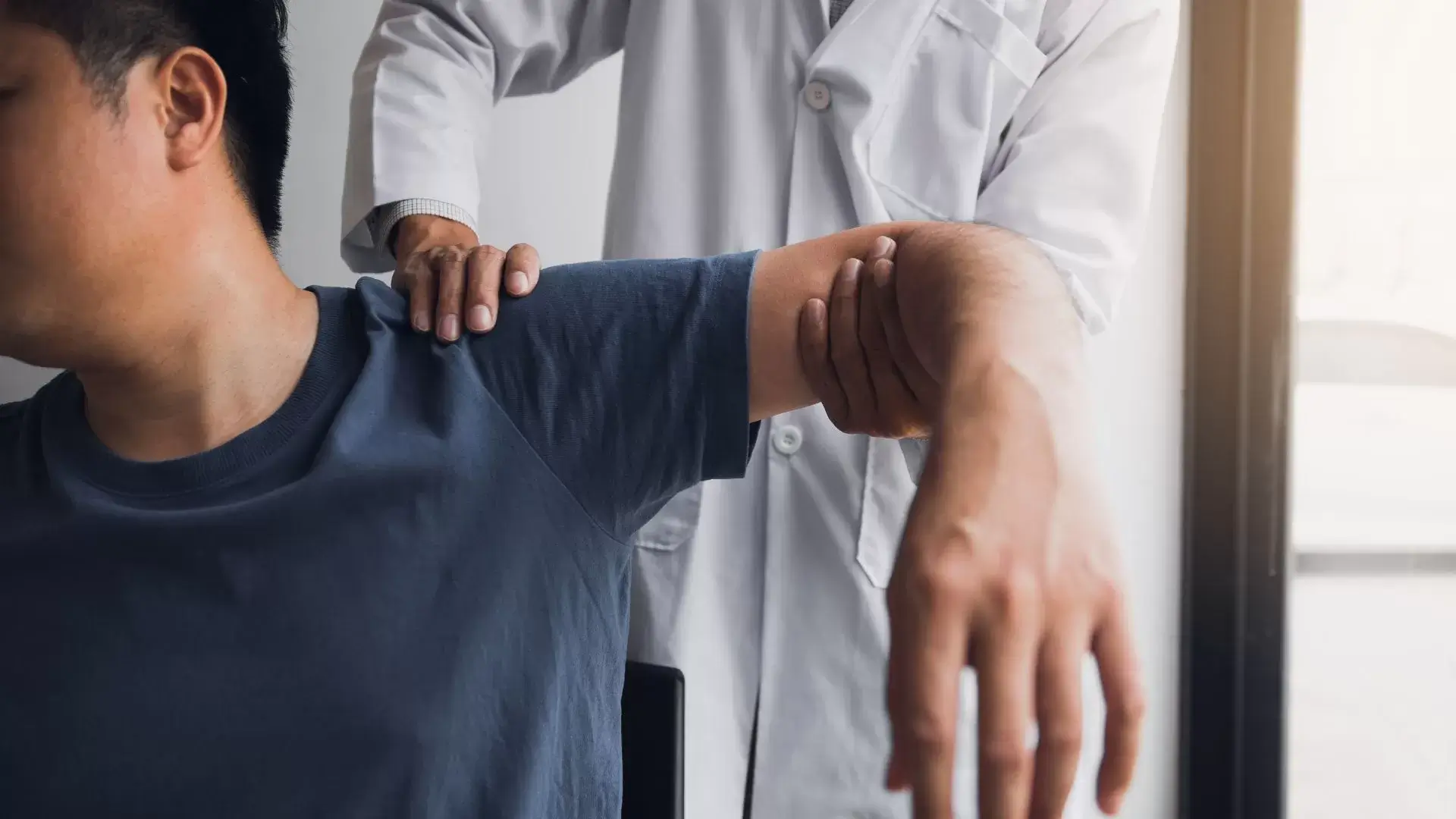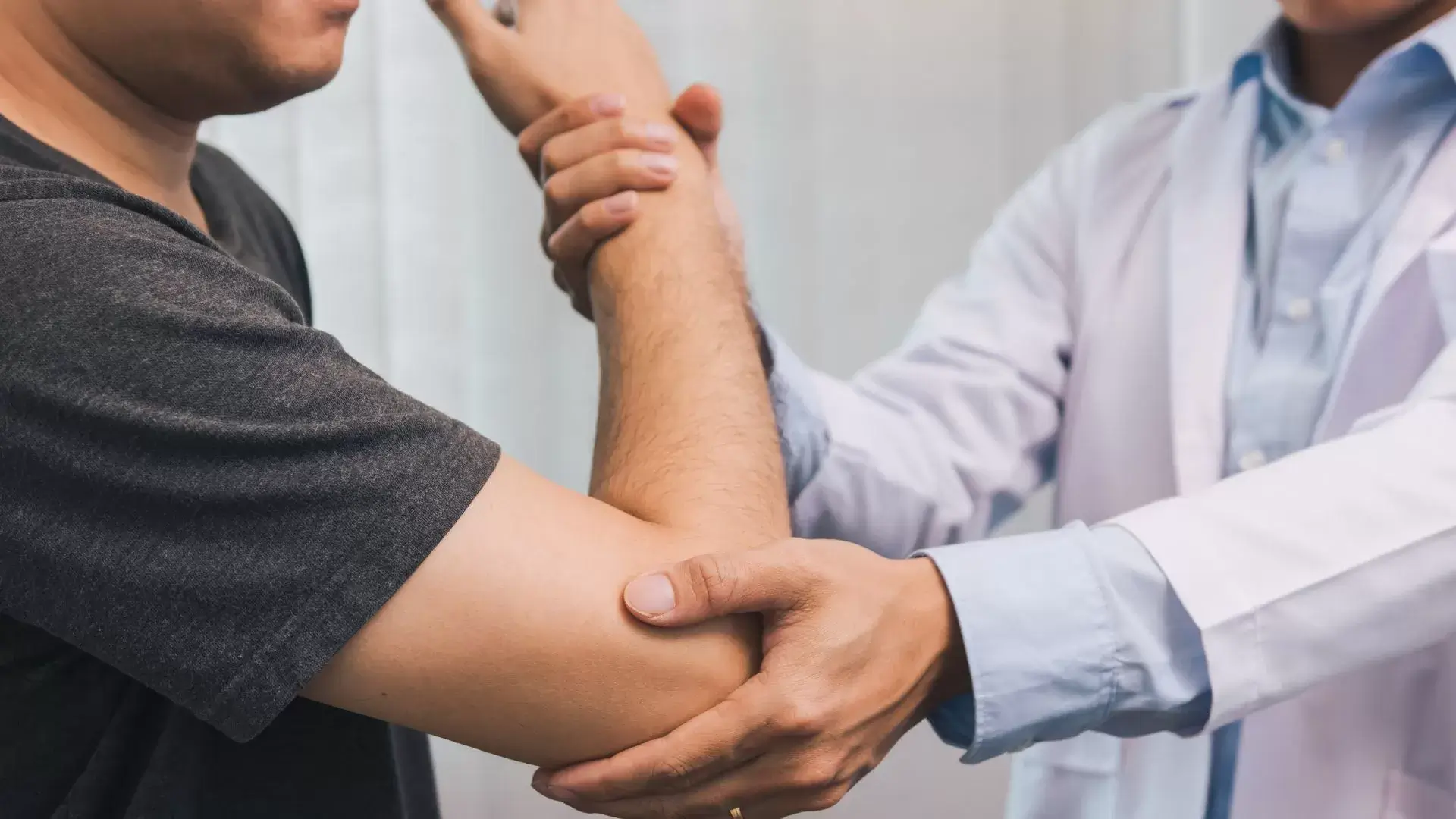If you’re looking for a chiropractor for golfer’s elbow in Mississauga, we’re here to help. Our Best Physiotherapy & Chiropractic Care in Mississauga focuses on reducing pain and improving function through personalized treatment plans. We utilize techniques like manual adjustments and soft tissue therapy to address the root causes of your discomfort. Additionally, we provide guidance on strengthening exercises and proper ergonomics to prevent future injuries. Our goal is to empower you in your recovery journey. As you explore our services, you’ll discover how our holistic approach can benefit your overall health and wellness.

At Mississauga Physio Chiro Clinic, we offer extensive physiotherapy and chiropractic services designed to effectively address and alleviate conditions like golfer’s elbow. Our dedicated team understands that elbow pain can notably affect daily activities and overall quality of life. Through a combination of elbow rehabilitation techniques, we aim to restore function and reduce discomfort.
We focus on non-surgical treatment options that include manual therapy and therapeutic massage, which promote inflammation relief and enhance circulation. These methods not only alleviate pain but also facilitate healing in the affected areas. Additionally, we implement tailored elbow mobility exercises to strengthen the surrounding muscles and improve flexibility, which is essential for long-term recovery.
Our pain management strategies are personalized to meet each individual’s needs, ensuring that we address the specific challenges presented by golfer’s elbow. By integrating our physiotherapy and chiropractic services, we work collaboratively with our patients to develop thorough treatment plans that yield positive outcomes. We’re committed to empowering our patients with the knowledge and tools needed for effective self-management, fostering a path toward a pain-free life and ideal elbow function.
Understanding the causes and risk factors of golfer’s elbow is essential for preventing and managing this common condition effectively. Medial epicondylitis, or golfer’s elbow, primarily arises from overuse injuries and repetitive stress, often impacting those who engage in activities that involve gripping or swinging motions.
We should be mindful that this condition can lead to elbow strain and forearm pain, greatly affecting elbow function. Tendon inflammation occurs around the medial epicondyle, where the forearm muscles attach, causing discomfort and grip weakness. Over time, those who frequently perform repetitive tasks, whether in sports or manual labor, may experience symptoms of elbow tendonitis.
Risk factors include age, as tendon elasticity decreases, and improperly executed techniques in sports or repetitive tasks that can exacerbate the injury. Recognizing these aspects can help us implement preventative measures. By addressing the underlying causes, we can facilitate elbow recovery and maintain overall arm health. It’s important to listen to our bodies and seek professional assistance when we notice the early signs of golfer’s elbow, ensuring we minimize long-term damage and promote healing.
Recognizing the key symptoms of golfer’s elbow is vital for timely intervention and effective management of this condition. We often notice inner elbow pain, which can range from a dull ache to sharp discomfort. This pain may be accompanied by elbow stiffness, particularly when we attempt to move our arm or grip objects. Elbow swelling can also occur, indicating inflammation from elbow tendinopathy.
Chronic elbow pain is another common symptom we may experience, especially after repetitive activities involving the forearm muscles. Muscle fatigue in the forearm can make it difficult to perform daily tasks, further impacting our quality of life.
To identify golfer’s elbow, we should pay attention to these symptoms and consider whether they stem from our activities or ergonomic adjustments. Implementing pain relief therapy, such as ice application, can help manage discomfort. Additionally, incorporating stretching exercises into our routine can improve flexibility and reduce stiffness.
If we find ourselves experiencing these symptoms consistently, seeking professional help is essential to address the underlying issues and prevent further complications. Early recognition and appropriate interventions are vital to recovery and maintaining an active lifestyle.
Chiropractic care offers a holistic approach to alleviating golfer’s elbow pain by addressing both the symptoms and the underlying musculoskeletal issues. We recognize that this condition often stems from tendon degeneration around the elbow joint, leading to persistent arm pain. By employing targeted techniques, we can help reduce inflammation and improve function.
Through tailored physical therapy, we focus on strengthening the muscles that support the elbow. This not only aids in recovery from golfer’s elbow but also helps prevent related issues, such as tennis elbow. Our treatment plan may include ice therapy for immediate relief and anti-inflammatory treatments to tackle swelling and discomfort.
Additionally, we address potential nerve compression that can exacerbate pain. By evaluating your posture and movement patterns, we can provide insights into proper elbow support and rehabilitation strategies. Our commitment to sports rehabilitation ensures that athletes can return to their activities safely and effectively.

Effective chiropractic adjustments can greatly enhance elbow joint function, promoting better movement and reducing discomfort associated with golfer’s elbow. By focusing on elbow mobility and flexibility, we can address underlying issues in elbow mechanics that contribute to pain. Our approach often includes evaluating joint stability and identifying any muscle imbalances that may hinder proper movement.
Through targeted adjustments, we improve elbow mechanics, allowing for better forearm strengthening and overall function. This is vital for athletes and individuals who rely on their arms for daily activities. In many cases, we also collaborate with occupational therapy to create a all-encompassing treatment plan that includes elbow strengthening exercises tailored to each individual’s needs.
Additionally, we may incorporate myofascial release techniques to alleviate tension and improve blood flow, further promoting chronic pain relief. By restoring balance within the muscles surrounding the elbow, we can enhance both flexibility and stability. Our goal is to empower you to regain full use of your elbow while minimizing discomfort. With our chiropractic adjustments, we believe you’ll experience a significant improvement in your elbow joint function, allowing you to return to your favorite activities pain-free.
How can soft tissue therapy play a crucial role in healing tendons and relieving muscle pain associated with golfer’s elbow? As we understand, conditions like golfer’s elbow often involve discomfort in the elbow tendons and can lead to wrist pain. Soft tissue therapy effectively targets these issues through techniques such as neuromuscular therapy and joint mobilization. These methods help release tension in the flexor tendons, promoting tendon healing and alleviating acute elbow pain.
Incorporating heat therapy can also enhance the benefits of soft tissue treatment, increasing blood flow and flexibility. After the initial healing phase, we can introduce resistance exercises to strengthen the muscles around the elbow, further reducing pain and preventing future injuries.
For those struggling with persistent discomfort, an elbow brace may provide additional support during recovery. By combining these approaches, we can create a thorough plan that not only addresses the immediate symptoms but also fosters long-term healing and strength. Ultimately, soft tissue therapy is an essential component of our journey toward reclaiming pain-free movement and performance.
Managing nerve compression and ulnar nerve pain is essential for golfers, as it can greatly influence their performance and overall quality of life. When we experience golfer’s elbow, it often leads to elbow injury and discomfort in the wrist flexor muscles, impacting our ability to play effectively. Through chiropractic care, we can address the underlying causes of ulnar nerve pain and nerve compression.
Chiropractic adjustments focus on restoring proper alignment, which can alleviate pressure on the ulnar nerve. This approach helps reduce inflammation and promotes healing, making it a preferred alternative to corticosteroid injections. Additionally, we may recommend the use of elbow orthotics to provide support and stability during activities, further minimizing the risk of repetitive motion injury.
It’s important for us to understand that managing these conditions not only helps with pain relief but also enhances our overall performance on the course. By working together with a chiropractor, we can develop a personalized treatment plan that addresses our specific needs, allowing us to return to the game we love with improved strength and mobility.
Incorporating strengthening and stretching exercises into our recovery plan can greatly enhance our ability to overcome golfer’s elbow and prevent future injuries. Focusing on our elbow ligament’s health is vital, especially for those of us who experience work-related injuries, manual labor injuries, or sports-related conditions like racket sports or throwing injuries.
We can start with wrist flexor stretches, gently extending our arm and pulling back on our fingers to lengthen the muscles. Strengthening exercises, such as wrist curls with light weights, can help build endurance in our arm biomechanics. Additionally, integrating PRP therapy, shockwave therapy, or ultrasound therapy can further support our recovery by promoting healing and reducing inflammation.
It’s essential to maintain a balanced routine, ensuring we address both flexibility and strength. We might also find that kinesiology taping offers support during our exercise regimen, helping stabilize the elbow joint while we rebuild strength. Remember, consistency is key in our rehabilitation journey. By committing to these exercises, we not only aid in recovery but also lay the groundwork for long-term elbow health, minimizing the risk of future injuries.
Kinesiology taping and bracing can provide essential support for our elbow, helping to alleviate pain and stabilize the joint during our recovery from golfer’s elbow. These techniques are particularly beneficial for those of us dealing with gripping injuries, as they enhance wrist stability and reduce strain on the affected area.
When applied correctly, kinesiology tape can help improve circulation, provide proprioceptive feedback, and support our muscles and tendons without restricting our range of motion. This allows us to engage in daily activities while protecting the elbow from further injury. Additionally, elbow splints can be incredibly effective in immobilizing the joint, especially during the initial stages of recovery or after elbow surgery.
For those of us in need of professional guidance, visiting a chiropractor at our local clinic, such as the one located at 1834 Lakeshore Rd W #6C, Mississauga, ON L5J 1J7, can be invaluable. We can reach out for personalized recommendations on taping and bracing techniques tailored to our specific needs. By incorporating these supportive measures, we can enhance our recovery journey and return to our favorite activities sooner.

Finding the right balance between ice and heat can greatly aid in reducing inflammation and alleviating pain associated with golfer’s elbow. Ice therapy is often our first go-to after an injury. It helps constrict blood vessels, minimizing swelling and numbing the sharp pain. Applying ice for 15-20 minutes, several times a day, can provide significant relief.
Once the acute inflammation subsides, shifting to heat can be beneficial. Heat encourages blood flow, which promotes healing and relaxes tense muscles around the elbow. We recommend using a warm towel or heating pad, again for 15-20 minutes, to soothe the area.
Incorporating these methods into our pain management routine, alongside chiropractic care, can enhance our recovery process. Chiropractors often suggest alternating between ice and heat to create a dynamic healing environment. This approach not only addresses the immediate discomfort but also supports long-term recovery by improving circulation and promoting tissue repair.
To further support our recovery and prevent future injuries, we can implement ergonomic modifications in our daily activities that reduce strain on the elbow. One effective strategy is to guarantee our workspace is set up to promote proper posture. By adjusting our chair height and desk arrangement, we can keep our elbows close to our bodies and our wrists in a neutral position. This simple adjustment can greatly alleviate unnecessary stress on the elbow.
Additionally, we should consider using tools designed to minimize strain. Ergonomic keyboards and mice can help maintain wrist alignment, while padded grips can reduce the force exerted during repetitive tasks. When engaging in physical activities, proper technique is vital. We can benefit from using our whole body rather than just our arms when lifting or reaching.
Chiropractic care offers effective solutions for managing chronic golfer’s elbow and recurrent pain, helping us regain mobility and alleviate discomfort through targeted treatments. By evaluating our individual conditions, chiropractors can develop personalized treatment plans that may include manual adjustments, soft tissue therapies, and rehabilitative exercises tailored to our needs.
One of the primary goals in chiropractic care is to restore proper alignment and function to the elbow joint and surrounding tissues. This can help reduce inflammation and improve blood flow, aiding in the healing process. Additionally, chiropractors often educate us on proper ergonomics and biomechanics to minimize strain during daily activities and sports.
In many cases, we may also benefit from modalities such as ultrasound therapy or electrical stimulation, which can further assist in reducing pain and promoting recovery. As we engage in these treatments, we’re encouraged to actively participate in our rehabilitation through prescribed exercises to strengthen the muscles around the elbow.
Ultimately, chiropractic solutions empower us to take control of our recovery, enabling us to return to the activities we love without the limitations of chronic pain. Together, we can work towards a healthier, pain-free future.
When faced with golfer’s elbow, we often find ourselves weighing the benefits of chiropractic care against the potential necessity of surgical treatments for effective recovery. Chiropractic care offers a conservative approach, focusing on spinal adjustments, soft tissue manipulation, and rehabilitation exercises. These methods aim to alleviate pain, improve function, and promote healing without invasive procedures. Many patients experience significant relief and enhanced mobility through consistent chiropractic sessions.
On the other hand, surgical treatments may be considered when conservative measures have failed, particularly in severe cases. Surgery typically involves removing damaged tendons or repairing tissue. While it can be effective, it also carries risks such as infection, prolonged recovery time, and potential complications.
Ultimately, deciding between chiropractic care and surgery depends on the severity of our condition, our overall health, and personal preferences. We should consult healthcare professionals to evaluate our specific situation and develop a tailored recovery plan. By considering both options carefully, we can make informed decisions that align with our goals for long-term health and mobility. Embracing a holistic approach can lead us toward the most suitable pathway for recovery from golfer’s elbow.
Proactive measures, including chiropractic care and strength training, can greatly reduce our risk of developing golfer’s elbow. By focusing on preventative strategies, we can maintain our overall joint health and enhance our performance in sports or daily activities.
Chiropractic care plays a vital role in this process. Regular adjustments can improve our spinal alignment, reduce muscle tension, and enhance mobility. This not only aids in recovery from past injuries but also helps to prevent future issues. As we incorporate chiropractic sessions into our routine, we can learn valuable techniques to guarantee our bodies are functioning at their best.
In conjunction with chiropractic care, strength training is necessary. By targeting the muscles in our forearms and wrists, we can build endurance and resilience against overuse injuries. Implementing exercises like wrist curls, reverse wrist curls, and grip strengthening can fortify these areas, considerably lowering our chances of developing golfer’s elbow.
Together, these proactive strategies create a thorough approach to our health. By combining chiropractic care with a tailored strength training program, we’re taking considerable steps toward preventing golfer’s elbow and promoting long-term wellness. Let’s commit to these practices for a healthier future.
Seeking expert chiropractic care for golfer’s elbow in Mississauga can greatly enhance our recovery and prevent further complications, guaranteeing we stay active and pain-free. By reaching out to skilled chiropractors, we gain access to tailored treatment plans that address our specific needs. These professionals utilize advanced techniques to alleviate pain and restore mobility, helping us regain our strength and functionality.
During our initial consultation, we’ll undergo a thorough assessment, allowing the chiropractor to identify the underlying causes of our golfer’s elbow. This personalized approach guarantees we’re not just treating the symptoms but addressing the root of the problem. They may recommend a combination of spinal adjustments, soft tissue therapy, and guided rehabilitation exercises to facilitate healing and improve our overall performance.
Moreover, maintaining open communication with our chiropractor is essential. We should discuss our symptoms, progress, and any concerns we have throughout our treatment journey. By collaborating closely with our chiropractic team, we can stay informed and empowered, leading to better outcomes.
In Mississauga, we have access to dedicated professionals who understand our unique challenges and are committed to helping us recover and enjoy our favorite activities without pain. Contact us now!
Nestled in the heart of the Greater Toronto Area, Mississauga boasts a vibrant community rich in diverse culture, thriving business sectors, and an abundance of recreational opportunities. As we explore this city, we can appreciate its unique blend of urban sophistication and natural beauty. With over 700 parks and numerous trails, Mississauga offers countless ways to stay active and engaged with nature, which is essential for maintaining our overall well-being.
Moreover, the city is home to a variety of cultural institutions, including art galleries and performance venues, fostering a deep sense of community. We can also take pride in Mississauga’s diverse culinary scene, reflecting the rich tapestry of cultures that call this city home.
As we navigate our daily lives in Mississauga, it’s important to prioritize our health and wellness. Access to quality healthcare, including chiropractic services, is readily available to help us manage conditions like golfer’s elbow. By embracing the city’s resources and community spirit, we can enhance our quality of life and support each other in our health journeys. Together, we can thrive in this dynamic city that has so much to offer.

When it comes to chiropractic treatment for golfer’s elbow, we typically see a range in duration based on individual needs. Most patients might require several sessions over a few weeks to notice significant improvement. On average, we often recommend a treatment plan spanning 4 to 6 weeks, with sessions occurring once or twice a week. We’ll continually assess progress, making adjustments as needed to guarantee ideal recovery and function.
While chiropractic treatment is generally safe, there are some risks we should be aware of. These can include temporary soreness, stiffness, or discomfort after adjustments. In rare cases, more serious complications, such as nerve damage or worsening of symptoms, can occur. It’s important for us to communicate openly with our chiropractor about any concerns and to guarantee our treatment plan is tailored to our specific needs and conditions.
We can usually continue playing golf while receiving chiropractic care, but it’s crucial to listen to our bodies. Our chiropractor will assess our condition and provide guidance on how to modify our game if needed. They might suggest specific exercises or stretches to support our healing process. It’s important to communicate any discomfort we feel during play, ensuring that our chiropractic treatment complements our golfing experience effectively.
When it comes to insurance coverage for chiropractic treatment, we should check with our individual providers, as policies can vary widely. Many plans do cover chiropractic services, but the extent of that coverage might depend on the specific diagnosis and treatment provided. It’s a good idea for us to review our insurance policy or contact our provider directly to confirm what’s included, ensuring we can make informed decisions about our treatment options.
When we prepare for a chiropractic appointment, it’s crucial to wear comfortable, loose-fitting clothing. This allows for easy movement and access to the areas needing treatment. We should avoid tight sleeves or restrictive fabrics that could hinder our range of motion. Opting for clothing like a t-shirt and athletic shorts can be a great choice, as it provides both comfort and flexibility. Let’s make certain we feel relaxed and ready for our appointment!
Reach out to us today to book an appointment or learn more about our services. Our friendly team is here to answer your questions and help you take the first step toward improved health and wellness.
(647) 372-1209

At our Mississauga Physio Chiro Clinic, we are dedicated to providing personalized care that addresses the root cause of your discomfort. With a team of experienced physiotherapists and chiropractors, we focus on restoring your mobility, relieving pain, and enhancing your overall well-being.